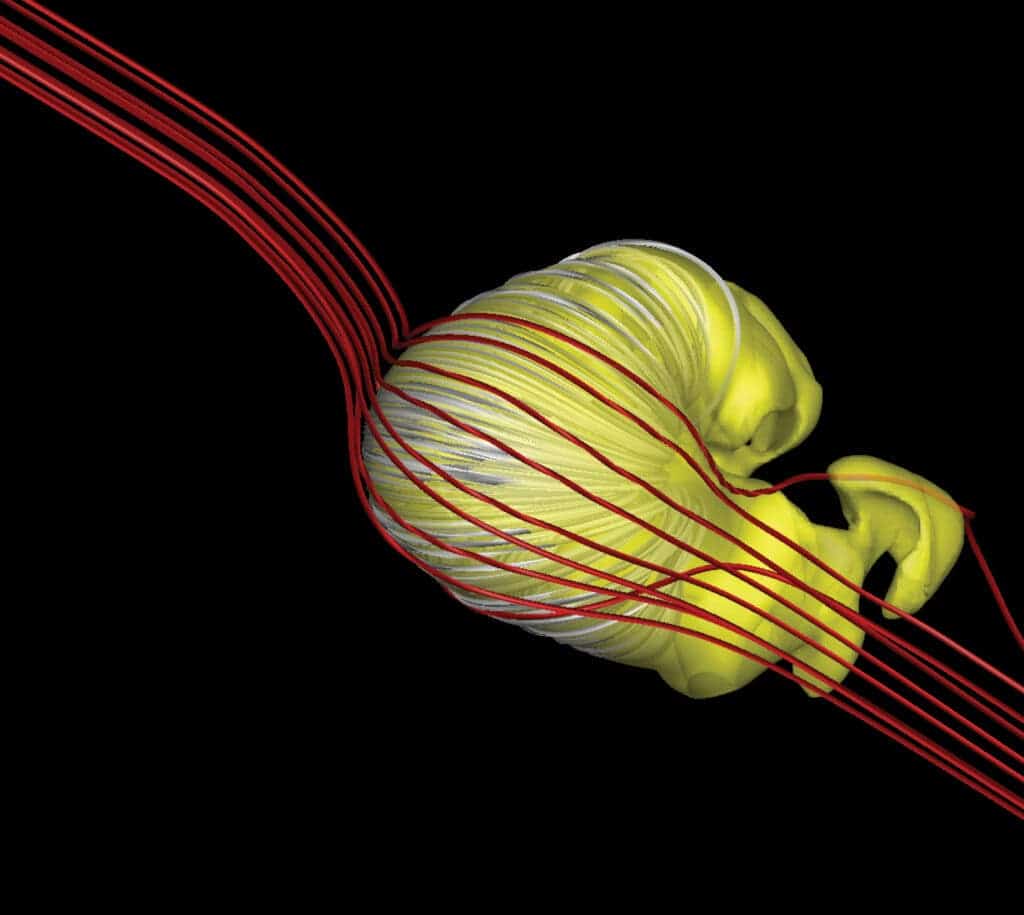New research at NASA developed a new prediction for the shape of the heliosphere, the magnetic bubble encasing our Solar System. But their result is not at all similar to the comet-like shape we’ve envisioned so far — in fact, it’s more of a “deflated croissant”, the agency reports.

Credits: Opher, et al. / NASA.
Outer space may be void, but it’s not completely empty. Magnetic fields and ionized gases permeate the galactic stretches between stars, and this substance is called the interstellar medium. It’s pushed back by the solar system’s magnetic ‘shield’, the heliosphere, just like Earth is protected from solar radiation by its own magnetic field. Using new data obtained from NASA’s crafts, the agency has developed a new model to describe the shape of this heliosphere.
Pastry-like shield
The shape of the heliosphere has been a point of interest of researchers for quite some time now. Traditionally, it is believed to have a comet-like shape with a long tail and a rounded leading edge (the ‘nose’). We believed it to be shaped in this fashion due to the Solar System zipping around through space.
However, researchers are now proposing an alternate model — the deflated croissant.
The shape of this heliosphere is very difficult to measure from within (where we are). For starters, it’s much too large for our sensors to be able to pick it up: its edge is around ten billion miles from Earth, according to NASA. Our only sources of direct data regarding it come from the two Voyager spacecraft that are well on their way to deep space.
We do, however, study this structure indirectly by capturing charged particles incoming to Earth from distant parts of the galaxy (cosmic rays). Alongside radiation formed by the Sun, these bounce back from the heliosphere, changing their physical properties in the process — and by studying them we can infer data about the heliosphere. In essence, we use this radiation the way a radar uses radio waves. This process is the one used by NASA’s Interstellar Boundary Explorer, or IBEX.
The latest iteration of the heliosphere model produced by NASA draws on data from the Voyager spacecrafts, the Cassini mission (to Jupiter), and the New Horizons mission (to Jupiter and Pluto). Using data from several points of the solar system allowed them to sample different types of particles.

Image credits: NASA’s Goddard Space Flight Center / Conceptual Image Lab.
“There are two fluids mixed together. You have one component that is very cold and one component that is much hotter, the pick-up ions,” said Merav Opher, a professor of astronomy at Boston University, director of the DRIVE Science Center at Boston University focused on the challenge, and lead author of the new research.
“If you have some cold fluid and hot fluid, and you put them in space, they won’t mix — they will evolve mostly separately. What we did was separate these two components of the solar wind and model the resulting 3D shape of the heliosphere.”
Modeling the behavior of these particles separately allowed the team to estimate the shape of the heliosphere. The end result was a “deflated croissant” shape, with a central body and two jets that trail chaotically behind it.
“Because the pick-up ions dominate the thermodynamics, everything is very spherical. But because they leave the system very quickly beyond the termination shock, the whole heliosphere deflates,” said Opher.
The shape of the heliosphere is of great academic interest, but its activity is a boon for us all. It blocks about 75% of incoming cosmic rays, which would otherwise make their way into the solar system. While our planet is protected by a magnetic field and an atmosphere, astronauts and spacecraft are not.
This shield then, despite being shaped like a disappointing pastry, may be the only thing that allowed us to ever get off the planet and into space without being deep-fried by radiation in the process.
By knowing more about the heliosphere, we can also better estimate which alien planets are candidates for life.


